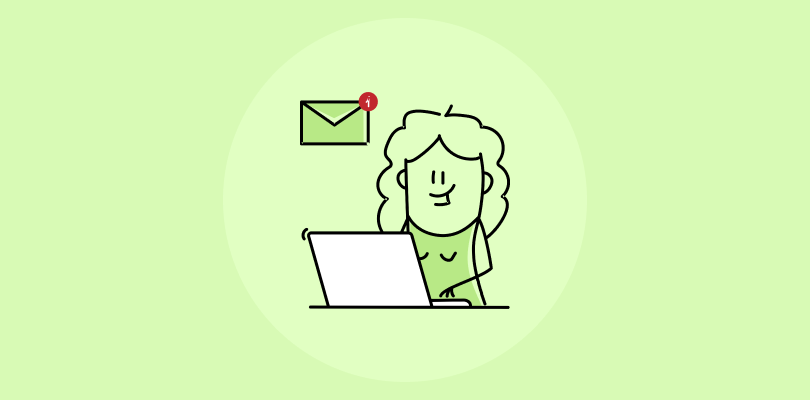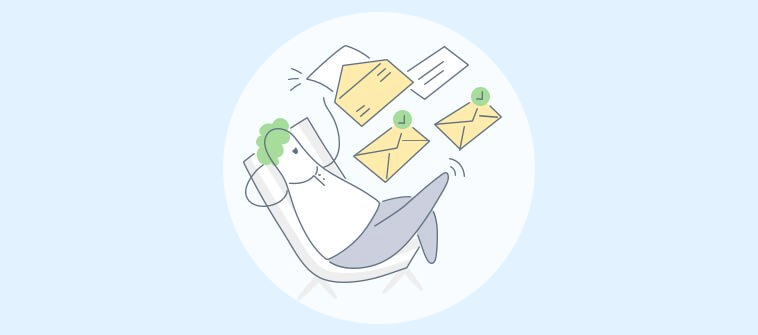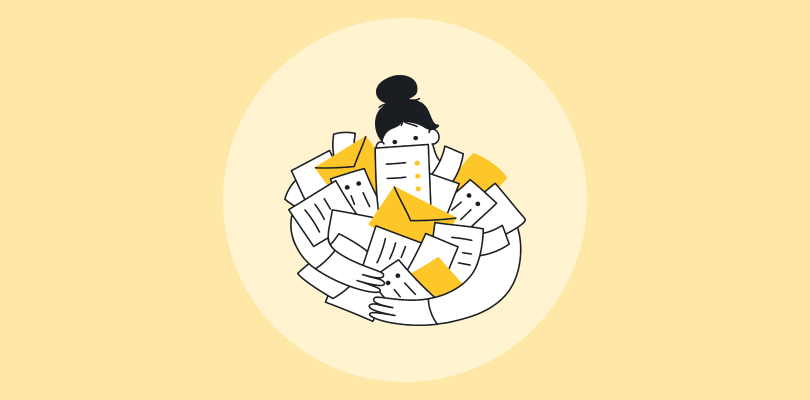Ask any working professional for email management tips, and they will give you a long list. Ask them how much time they are still spending on email, and you will likely hear – “A lot! Most of our day.” Isn’t it surprising?
Without proper management, your email can quickly spiral into a relentless stream of notifications that consume your productivity and overwhelm your daily routine.
In this blog, we’ll understand what email management is and its benefits. We’ll also explore essential email management tips to help you tame your inbox, boost your efficiency, and reclaim your focus.
What Is Email Management?
Email management refers to the systematic approach to handling incoming and outgoing emails in an efficient and organized manner. This practice is crucial for individuals and businesses to ensure effective email communication, minimizing clutter, and maximizing responsiveness.
Effective email management involves organizing emails into folders or categories, using filters to prioritize or redirect messages based on specific criteria, and employing rules to automate tasks such as sending canned responses or archiving.
Strategic email management helps keep the inbox tidy and significantly reduces the time spent managing emails, allowing more focus on other critical tasks.
What Is Email Management Software?
Email management software can help you manage all your incoming and outgoing emails in one place. These tools typically offer features like automation for assigning emails to specific members or teams, creating rules for prioritization, and receiving alerts when a response is overdue.
Additionally, they often include capabilities for email ticketing and tracking response times. Individuals, as well as groups, can use email management tools.
For instance, you can manage your work email account, “John@company,” and communicate better with stakeholders. Similarly, teams can use this tool to manage team inboxes such as “support@company” and collaborate to resolve customer issues faster.
What Are the Benefits of Email Management?
Effective email management offers several key benefits that can enhance productivity and streamline communication. Here are five notable advantages:
- Increased Efficiency: By organizing emails and reducing clutter, individuals can navigate their inboxes more quickly and respond to important messages faster, enhancing overall productivity.
- Improved Response Time: With structured systems such as automated sorting and prioritization, emails are handled more promptly, which is crucial for maintaining professional relationships and quicker response times.
- Reduced Stress: A cluttered inbox can be a source of constant stress. Efficient email management helps in reducing the mental load, making it easier to focus on the task at hand without the distraction of an overwhelming number of unread emails.
- Enhanced Security: Good email management practices include regular cleaning and archiving, which can reduce the risk of security breaches by limiting exposure to potentially harmful emails and phishing attempts.Additionally, performing a DMARC test email can help ensure your email security protocols are functioning correctly.
- Better Collaboration: For teams, effective email management can mean shared inboxes, clear tags, and categorizations, which streamline collaborations and ensure everyone is on the same page without missing critical communications.
Read More: 10 Templates to Write the Best Apology Emails to Customers
15 Email Management Best Practices and Tips
Managing an over-flooded inbox can seem scary, but here are 15 tips on managing emails that can help you out –
1. Dedicate a Specific Amount of Time to Email
Most people have no idea how much time they spend browsing, sorting, deleting, or replying to their business emails. But it’s more than you think.
As per a recent Statista study, US workers, on average, spend more than five hours per day checking their work and personal emails.
To manage emails effectively, dedicate a particular time in the day for email – it can be a few minutes or hours, depending on the nature of your job. The next time you check your inbox, time yourself.
Once you are about to close, see the amount of time spent and ask yourself. “Could I have done it in less time?”
Remember, even if you get long emails, the response does not necessarily have to be lengthy. Avoid spending more than one minute on a single email and get closer to your goal of inbox zero.
2. Invest in the Right Email Management Software
When you talk about inbox management tips and tricks, nothing works better than investing in the right tool. Email technology has gradually improved over the years, and you should make the most of it.
Here are some must-have features of email management software:
- Email Prioritization & Sorting: With an email management system, you can adjust the priority of incoming emails by marking them as High, Low, or Normal. This will ensure team members know which emails they must work on first. Also, unique labels or tags can be added to emails for better organization.
- Shared Inbox: It makes managing your team email accounts (support@, info@, inquiries@, etc.) a breeze. You can see who is working on which email in real time and avoid sharing duplicate replies.
- Email Analytics: Email management tools are known for their robust reporting capabilities. For instance, you can monitor team performance and email response times and check all your pending emails from a single dashboard.
3. Turn Email Notifications Off When Not Working
The modern-day worker is constantly connected to the world via the internet. No wonder a single minute of internet downtime feels like the world has halted.
Having your email notifications on throughout the day can lead to mental fatigue and distractions, impact your personal life, and deteriorate relationships.
Even if you have set a dedicated time to check your emails, you might find it hard to resist the sound of notification alerts. And as soon as you try to click on the notification and start checking emails, you realize you are caught in a never-ending loop.
So, as soon as you leave work, ensure your email notifications are turned off. You must turn it on only when expecting an urgent email from someone.
4. Personalize Your Inbox With Themes
Who said your email interface has to be boring? When you have to spend a lot of time checking or answering emails, the look and feel of your inbox can influence your mood and energy levels.
Colors and images have the power to influence one’s behavior. For instance, the color yellow is known to evoke feelings of happiness and enthusiasm. Similarly, peace and serenity are evoked by the color blue.
Depending on your email client, you can explore multiple customization options.
For instance, with Gmail, you can select the density of the text and inbox type, choose an appropriate theme, or upload an image from your computer. As you select a theme, you will see your inbox change to it immediately.
You will notice positive changes even by making small changes to your inbox’s background. Opening a personalized inbox right in the morning can lead to a kickass start to your workday.
5. Use Pre-Made Templates for Common Emails
This email management strategy is a significant time-saver if you frequently deal with the same type of emails. All you have to do is create several templates for the most frequent scenarios and then tweak them to the current circumstances before hitting the send button.
With pre-made templates, you won’t have to constantly waste time typing the same replies. Instead, you’ll be able to refocus and pay attention to more complex and demanding tasks.
But you must also remember that using templates as it is can make an email response look impersonal and automated. To add a healthy dose of personalization, use people’s names, try to ask questions to understand their unique challenges, or use some humor every now and then.
Read More: 20 Customer Service Email Templates for Super-Fast Responses
6. Avoid Opening Irrelevant Emails
Businesses are spending millions of dollars, and marketing experts are working day in and day out to make you open their emails. No wonder we all have received emails with extremely catchy subject lines.
The truth is that not all emails that land in your inbox deserve your attention. Avoid opening cold emails, which will consume your time and impact productivity.
Avoid clickbait emails where the sender intends to grab your attention and make you click on a particular link. Avoid opening emails claiming unreasonable discounts, gift vouchers, or where the subject line claims something fishy like“Double your sales in one week.”
Once you make this a habit, you can smell irrelevant emails from far away and save valuable time. Instead of opening them, you can delete them directly and keep your inbox clean.
7. Enhance Speed With Keyboard Shortcuts
Using keyboard shortcuts is considered one of the best tips for managing emails. For example, you can highlight (bold) an important text in your email body by pressing the keys ‘Control’ + ‘B.’
Keyboard shortcuts are a productivity booster. Right from composing, searching, and navigating to writing emails, there is a lot you can do by pressing the right combination of keys.
For example, Gmail offers a wide range of keyboard shortcuts that let you work faster and use the mouse less often. To activate shortcuts, all you need to do is turn them on.
The best part is that most email clients allow you to customize your keyboard shortcuts. You can choose which keys will perform which function and get better at managing your email load.
8. Use Automated Replies When You Are Unavailable
There will be times when team members are not available to take chats or respond to emails. In such a scenario, automated replies can help you let senders know about the current situation or by when they can expect an ideal response.
An automated response is useful if you’re on vacation or out of the office due to some unpredictable circumstances. This way, you’ll prevent misunderstandings and recipients’ frustrations.
Here is an example of an automated email response:
Automated replies are usually triggered within a few seconds after receiving the message. Moreover, they can also be used for responding to customer complaints, letting them know that your team has received their issue.
Read More: 10 Service Desk Automation Ideas that Boost Performance and Quality
9. Keep Your Replies Clear & Jargon-Free
Drafting clear and concise replies is considered a top email management best practice. You may want to rewrite your email body if your reply uses difficult words or is full of technical jargon.
Just like you try to follow principles to minimize your time spent on handling emails, you should try to make other people’s lives easier by sharing easy-to-read emails.
Your customers, business clients, partners, or key stakeholders will likely appreciate clear and precise emails without unnecessary digressions and redundant information. After all, no one wants to receive a complex reply that seems more like a puzzle.
This approach will also help you increase your email open rates and get faster responses.
10. Unsubscribe From Newsletters that Don’t Bring Value
While newsletters can offer you handy information, they are not always necessary, especially if you don’t use the product or service anymore.
Don’t feel guilty. Hit that ‘Unsubscribe’ button quickly if the newsletter from a brand does not bring any value. There is no point in cluttering your inbox with useless emails.
This is one of the most important recommendations among the email management tips that increase your efficiency and save you from distractions.
The truth is that people frequently aren’t aware of how much time they spend scrolling through useless emails, even if they just open them to delete them or label them as irrelevant. So, once you simply unsubscribe and stop random useless newsletters and automated emails from distracting you, you may double up your productivity.
11. Make Sure to Address All the Points
To establish impeccable email communication, you shouldn’t only pay attention to the technical aspects of your tone and the information you provide.
Dedicate enough time to read the content when you receive important emails. Try to break the content body into points so you can address them separately in your reply.
So, to achieve a sleek communication flow, you should:
- Check if you’ve replied to all the questions asked by your correspondent
- Do not repeat the same question if your correspondent has already provided an answer
- Always ask if there are any additional questions or help someone needs
Learning how to manage work emails will never be easy. However, you can craft the best email responses by being attentive, empathetic, and patient.
12. Introduce a ‘No-Reply Policy’ for Certain Types of Emails
Let’s be honest; not every email out there deserves your response. In some cases, no reply is a pretty clear reply as well.
Be sure to use the ‘no-reply policy’ only for emails that won’t jeopardize your business reputation and performance.
For instance, you can leave a sender without a reply if:
- It seems like a circular email that isn’t relevant to your business
- It is a promotional email selling something that you do not need
- The sender asks you to reply only if you’re interested in collaboration
- It is a simple “Thank you” email response from a customer or business partner
However, you must be extra careful so team members don’t misuse this option. Some important emails deserve a response, particularly if they need you to address major, time-sensitive concerns.
13. Be Smart About Your Subject Lines
Just like you may decide if you will read an email based on its subject line, you should remember that somebody else may evaluate your email similarly. The subject line of your email is considered the most important few words in the entire email.
Your email management skills and knowledge are incomplete if you do not know how to write the best subject lines. After reading your subject, the receiver must be enticed and say, “TELL ME MORE!”
So, make sure to name your email in a clear and precise way that lets the recipient understand the content. Keep the subject short yet interesting enough to catch the attention of your target audience. The optimal length of an email subject line can differ based on various elements, but it is typically advised to maintain it between 30 to 50 characters or 4 to 7 words.
The more room you leave for them to question the importance of your email content, the more likely they will postpone reading it.
14. Check Your Spam Folder Occasionally
We know that your regular email handling may require a lot of time and effort, but you shouldn’t forget to check your spam and junk folders from time to time.
Important emails might be hiding in your Spam folder – an attractive business deal, an appreciation from a customer, or an urgent request.
A Spam folder is a designated folder where all your unwanted or junk emails are stored. Some clients automatically mark emails as spam and add them to this folder. You can also manually report emails as spam to avoid receiving them in the future.
Sometimes, it may happen that an important email accidentally ends up in your Spam folder. So, to avoid jeopardizing your business performance and communication, ensure you haven’t left anything valuable unanswered in these sections.
15. Double-Check Your File Attachments
One of the greatest aspects of email is sharing important documents with customers, business partners, etc. However, have you ever forgotten to attach these important documents to the email body? Don’t worry; you are not alone!
Emails without relevant file attachments can lead to embarrassment, unhappy customers, and lost deals. No wonder it’s considered one of the biggest email sins.
Is it worse to send a wrong attachment to your recipient or to say you’re sending a document without actually attaching one?
Whatever your answer to this question, do your best to avoid this scenario, as both options may make you seem unreliable and unprofessional. So, before sending your email, ensure your attachments are carefully selected and properly attached. In short, double-check your file attachments before you hit the send button.
FREE. All Features. FOREVER!
Try our Forever FREE account with all premium features!
Become the Master of Your Inbox With Effective Email Management
Email has become a fundamental communication tool in both personal and professional settings, often serving as the first touchpoint for opportunities, collaborations, and essential information.
As you can see, there is a diversity of tips that you can rely on to become better at organizing your inbox. By choosing the right combination of tips for email management, you can save time, optimize your communication, and delight your audience with faster responses.
You can use a tool like ProProfs Help Desk to become a pro at managing customer emails. With powerful automation features like canned responses and automated routing, you can save time and respond faster. Moreover, organization tools like priorities, labels, and custom statuses can make your life much easier.
 Tips
Tips
We’d love to hear your tips & suggestions on this article!
Write Here
FREE. All Features. FOREVER!
Try our Forever FREE account with all premium features!
 We'd love your feedback!
We'd love your feedback!
What did you like & how can we make it even better?
 Thanks for your feedback!
Thanks for your feedback!
 Ask Your Question
Ask Your Question
Have a question? Get expert help to make your decision easier.
 Thanks for your feedback!
Thanks for your feedback!








